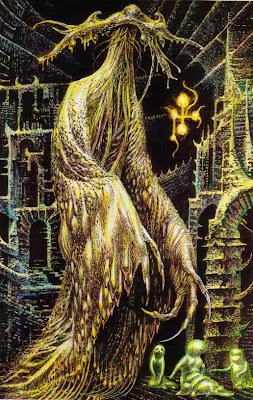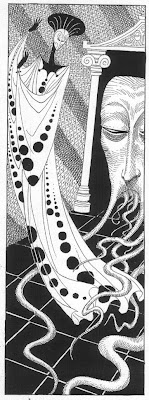.

Las estatuillas votivas de los orantes siempre me resultaron sumamente misteriosas; eran dejadas por los adoradores en los templos como signo de devoción eterna a los Anunnakki (dioses). Los ojos enormes que parecen mirar más allá del mundo mortal, la media sonrisa que parece guardar algún secreto místico, encarnan para mí el espíritu de Sumer, tal vez la civilización más antigua del mundo.
En estas páginas vemos cómo el protagonista cae al Apsu, el oscuro océano subterráneo cuyas aguas alimentan todos los ríos y arroyos de la tierra, morada de Enki, el dios de cola de pez. También moran en ese mar escondido unos extraños y enigmáticos personajes vestidos con pieles de pescado, los Apkallu, sabios en sortilegios.
En el último cuadro de la última página, el guerrero que combate contra el demonio negro lleva un casco basado en el del rey Meskaladimug de Ur, que fue robado del museo de Bagdad cuando entraron las tropas americanas y cayó el régimen de Saddam.
The votive statuettes which represent praying worshippers are the epitome of Sumer´s mystery; people placed them at the temples as a token of eternal devotion to the Anunnakki (gods). The enormous eyes which seem to look beyond the mortal world, the half-smile which seems to conceal some mystical secret, embody the ridle of the Sumerians, creators of what may well be the world´s most ancient civilization.
In these pages we see the protagonist falling to the Apsu, the subterranean ocean which nourishes with its waters all the rivers and streams of the orb, dwelling of Enki, the fish-tailed deity, and of the strange and enigmatic fish-garbed Apkallu, wise in enchantments.
In the last page, the warrior fighting against the black demon is wearing a helmet based on the one which belonged to king Mesakaladimug of Ur. That helmet was stolen from the Baghdad museum when the American troops defeated Saddam.





























































